The CEO’s view
Herfy’s vision is to develop world-class products and, in the process, to play a leading role in the development of the Saudi food industry. The company has become largest and fastest-growing chain of fast food restaurants in the Kingdom and one of the region’s largest and most integrated food service companies. It includes fast food restaurants, two bakery factories, a state-of-the-art meat processing plant and three other factories in the works.
The CEO notes that its honor to watch 100% Saudi-owned company become a symbol for world-class quality
Organization Overview
Herfy Food Services Company, Ltd was incorporated in 1401H/1981G, by Ahmed Bin Hamad Al-Said and Hamud Bin Saad Al-Ibrahim. For the last 33 years, the company has recorded tremendous success as the Kingdom’s biggest and most successful fast food brand, dominating the Saudi market (Herfy Food Services Company, 2014).
The company is synonymous with world-class Saudi quality, entrepreneurship and innovation. It includes a successful reputation built on its market-leading restaurants, bakery & sweets, and meat processing businesses.
The vision of the future inspired by the demand for fast food led to the start of the company. In 1982, Herfy started to make its own bread to ensure high quality standards of food.
In 1418H/ 1998G, Al Azizia Panda United was incorporated with the Savola Group headed by its Chairman, Eng. Adel Fakeh. Since then, Herfy has been operating in partnership with the Savola Group.
In 2008, Herfy Food Services Company, Ltd. has become a closed joint stock company.
Crowning its success early 2010, Herfy has been the first company in the year to be a Public Joint Stock Company, floating 30% of its shares for public subscription, and successfully joined Saudi stock market.
Some changes in administrative strategies have changed the company into a lean, powerful organization. As a result, the company is focused on an aggressive expansion program to compete with the largest international brands operating in the fast food and food production market.
Through it all, Herfy has grown into the Kingdom’s biggest and most successful fast food brand, dominating the Saudi market.
The last 33 years have defined the company’s success beyond Saudi Arabia. Today, there are Herfy’s branches in Bahrain, United Arab Emirates (Abu Dhabi, Al Ain), Kuwait, Egypt, and soon, Lebanon.
The company has plans to open more Herfy branches in other Gulf countries. With over 25 years of fast food expertise and success, the company intends to challenge leading food chains in the region and beyond (Herfy Food Services Company, 2014).
Moreover, Herfy’s non-restaurant branches are also poised to expand their presence in both the local and regional market. The company has embarked on improving its bakery items and soon processed meat products continue to come out of Herfy’s modern factories.
Herfy continues to invest in product development and state-of-the-art technology as it seeks to achieve its long-held vision to become one of the region’s leading food services brands.
Financial Statement Overview
Herfy demonstrated strongest performance in the year 2013 than any other periods. The company’s revenues slightly increased to SAR 848.7 million relative to the previous year, which was SAR 842.02 million. At the same time, the fiscal year also resulted into higher net income of SAR 191.4 million with earning per share of SAR 5.8.
Herfy has managed to control its general and administrative costs and barely managed to reduce it with a small amount. This shows that the company has focused on lean operations to control costs.
Herfy’s balance sheet has continued to grow over the years as it expands to other regions through new establishments or franchises.
The company’s senior executives believe that the current success has positioned the company for even more growth beyond the borders of Saudi Arabia (Herfy Food Services Company, 2014) and plans are already afoot to open more Herfy branches in other Gulf countries.
Financial Statements Analysis
The four-year trend shows that the company’s revenues have grown from SAR 579.93 million, SAR 708.57 million, SAR 842.02 million to SAR 848.70 million for the fiscal year periods of 2010, 2011, 2012, and 2013 respectively. These figures represent good growth margins. At the same time, gross profits have increased from 39.05%, 37.56%, 37.09% to 38.17%, which are SAR 226.46 million, SAR 266.15 million, SAR 312.34 million, and SAR 323.95 million respectively for the same financial years.
The company’s net income has increased SAR124.27 million in 2010 to SAR191.42 million in the year 2013.
The total equity reached SAR 600.84 million in 2013 from SAR 380.24 million in the year 2010.
Herfy has also recorded strong performances in cash flow activities. For instance, Cash Flow from Operating Activities increased from SAR 157.19 million in the fiscal year 2010 to SAR 213.16 million in the fiscal year 2013. At the same time, Cash Flow from Investing Activities have risen from SAR -81.59 million to SAR -111.04 million in the same period.
Income Statement
As previously mentioned, the company’s sales have continued to increase relative to the previous year. The income statement shows that Herfy managed to control costs of sales in the year 2013 at SAR 575.5 million relative to the year 2012 when it was SAR 575.6 million. This allowed Herfy to have slightly higher gross profit in the year 2013.
Although expenses increased, Herfy has focused on reducing its general and administrative costs.
As a result, net income for the year 2013 increased SAR191.42 million. In addition, earnings per share also increased marginally to 5.8 from 5.49.
Financial charges have doubled between the year 2012 and 2013. For instance, they rose from SAR 5.9 million to SAR 10.3 million.
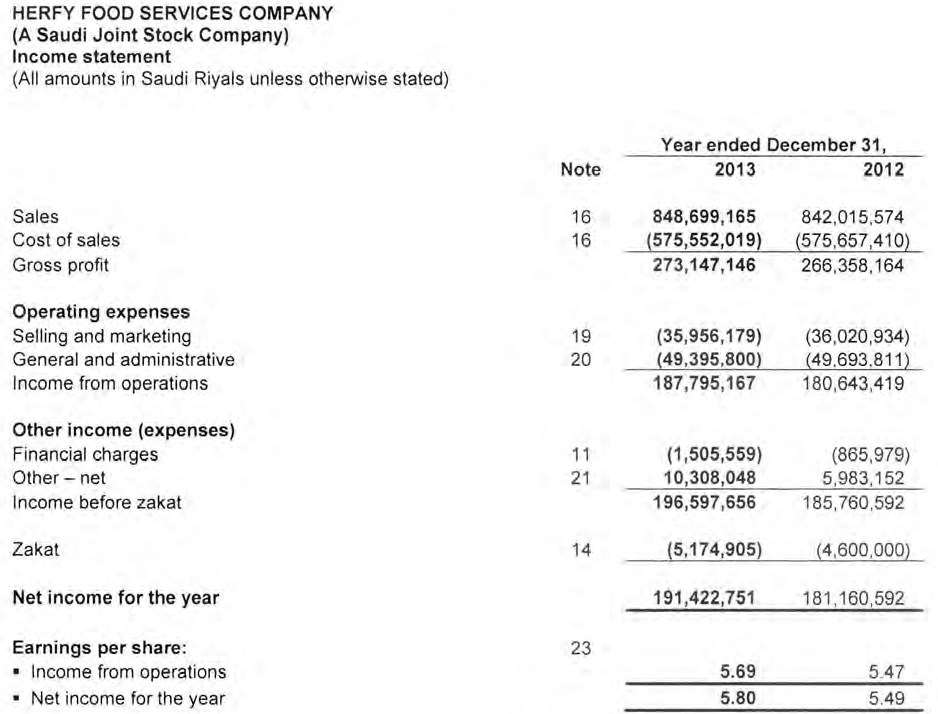
Analysis of cash flow
Herfy recorded increased net income for the year 2013. The income increased from SAR 181.2 million to SAR191.42 million. At the same time, net cash generated from operating activities declined from SAR 241.4 million to SAR 218.6 million for the year 2012 and 2013 respectively.
The company has continued to register negative returns from its investment activities. However, this declined in the fiscal year 2013 to -116.5 from 156.6 in the year 2012. Given the ongoing investment activities, cash used in financing activities also increased to 105.1 from 82.3 for the year 2013 and 2012 respectively.
At the end of the year, cash and cash equivalent declined to 57.3 compared to 60.2 noted in the year 2012.
Although the company has recorded increased revenues, most of its investments are yet to return expected incomes.
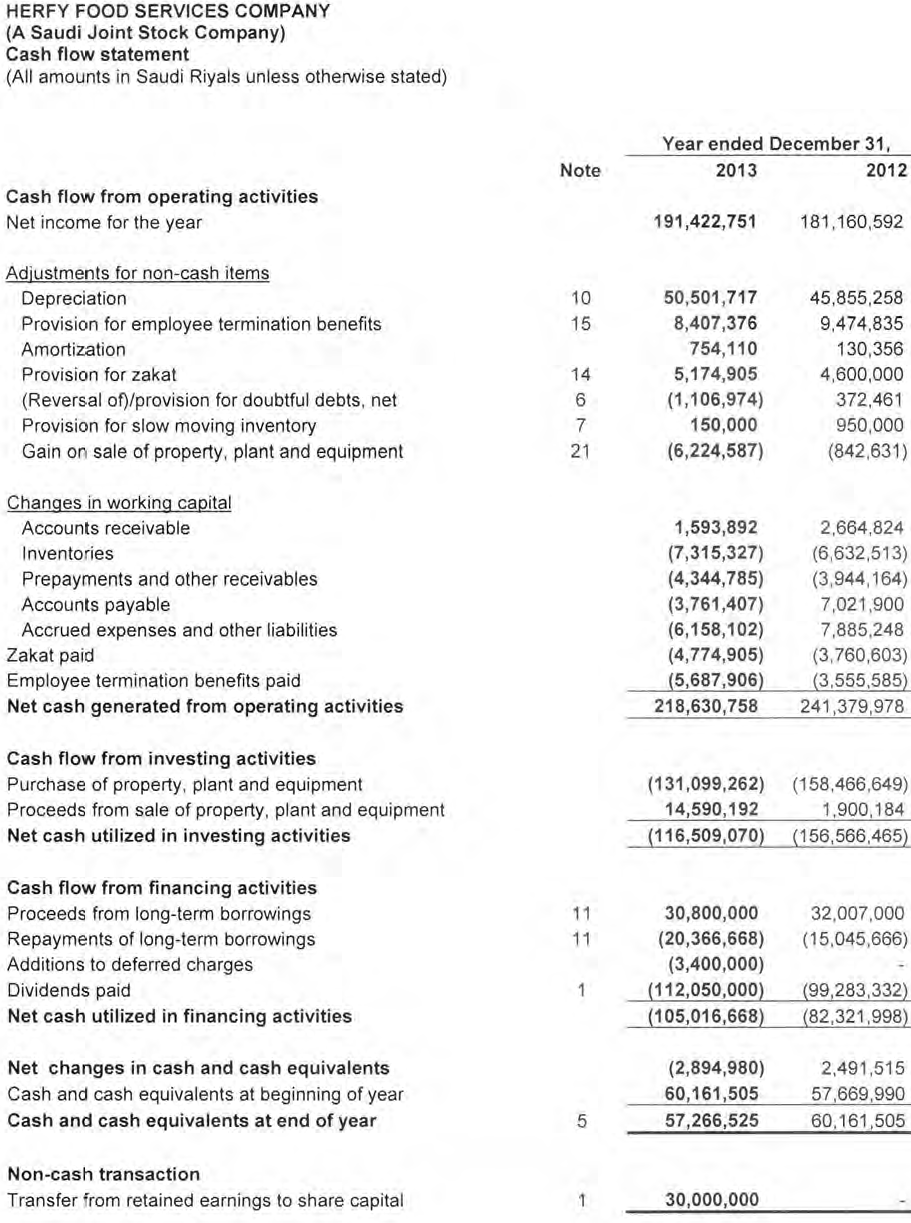
Stock performance analysis
Herfy’s stock performance has increased from SAR 28.9 in February 2010 to the current SAR 89.0 in 16 December 2014(Tadawul, 2014). It is imperative to note that the highest recorded share price for the company was SAR 108.55 in August 2014. This implies that the share price has declined in the last four months. This decline could be attributed to the following of global oil prices, which have influenced the Saudi markets.
Today, the company lost SAR -5.91 which represented -6.23%. This is not a good sign for potential investors.
Investors must understand market fundamentals for last four months before making any investment in the company.
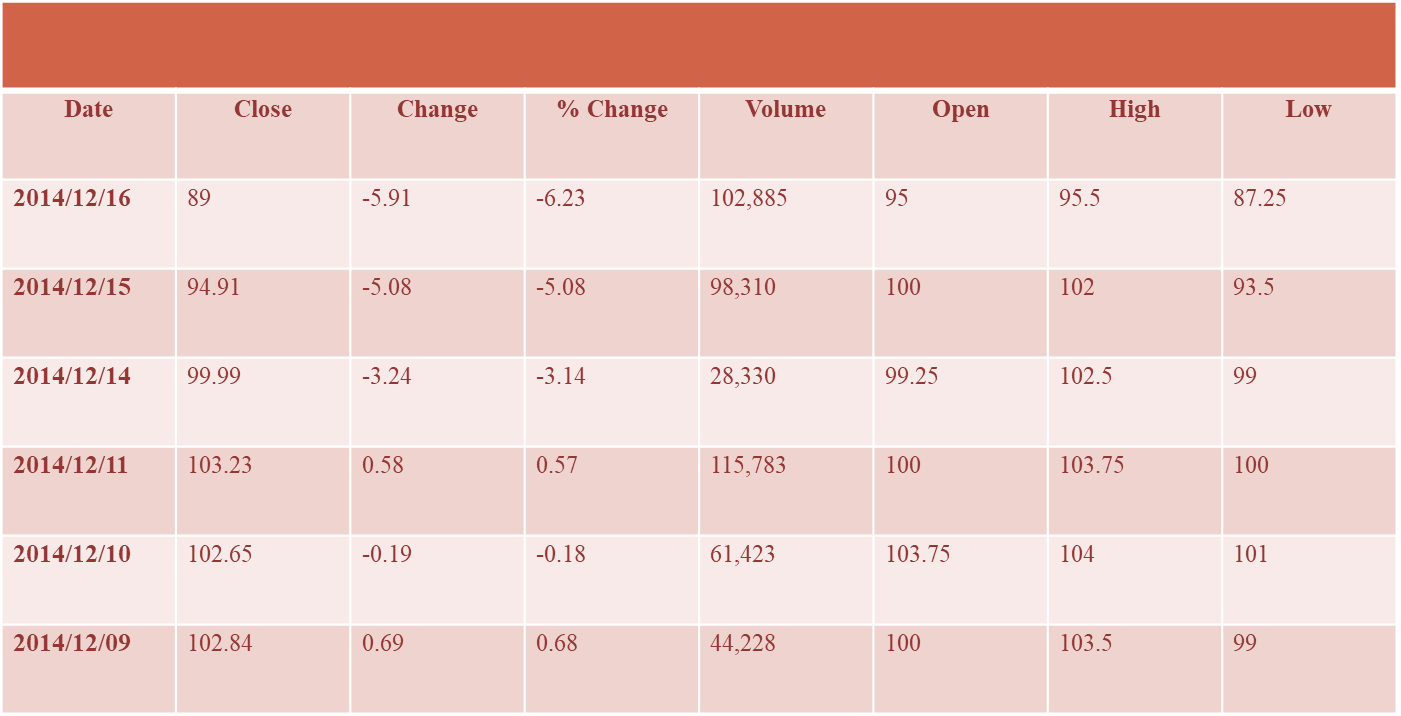
Cost of capital or required return on investment
Cost of capital is a major source of concern for investors. Investor use cost of capital to evaluate new projects and determine the minimum return that they expect for availing capital to the firm, thus setting a benchmark that a new project has to meet (Brealey, Myers, & Allen, 2013).
The company’s long-term debt are now SAR 38.4 million, which has risen relative to the previous year. Currently, cash flows from investing activities have declined to SAR 116.5 million from SAR 156.6 million noted in 2012. Net cash utilized in financing activities have increased to over SAR 105 million.
Herfy is focused on both local and regional growth. Hence, it must use other methods to raise capital, including bank loans and floating more shares to the public. With the following stock prices, this might not be the best option to raise capital.
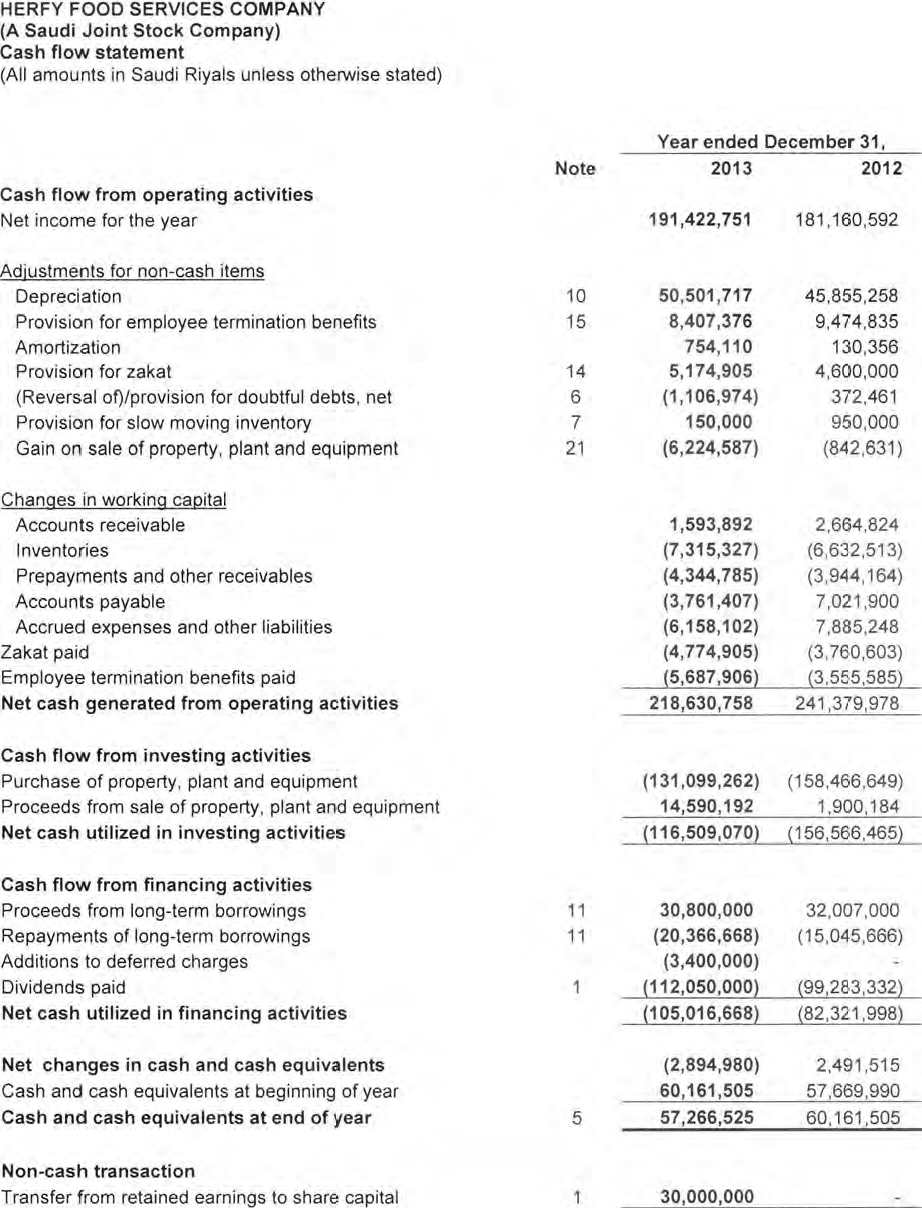
Return on investment
Herfy’s shareholders unanimously agreed to increase the share capital of the company to SAR 330 million from the SAR 300 million. The company used retained earnings of SAR 30 million to increase the share capital. The company has 33 million shares with SAR 10 for every share.
Additional share capital is necessary because of the ongoing investments in new outlets in Saudi Arabia and other Gulf states.
The company pays out dividend to shareholders, which increased from SAR 52.5 million to SAR 57.5 million.
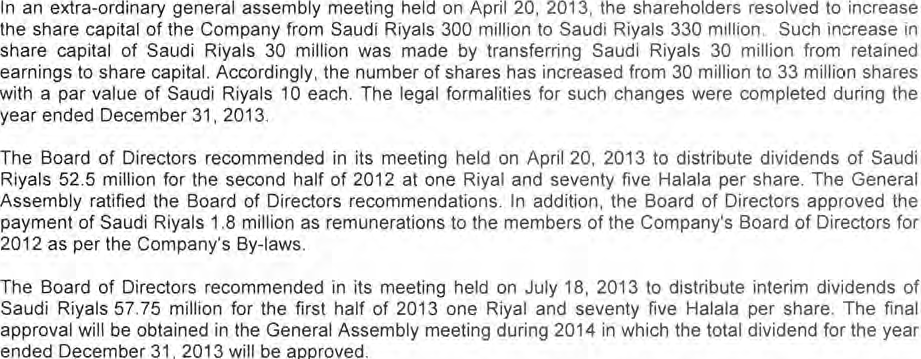
Value of the organization: book value
Herfy’s balance sheet has grown significantly for the last four years. For instance, the company’s assets increased from SAR 707.4 million to SAR 790.4 million between the year 2012 and 2013. At the same time, its liabilities increased from SAR 185.9 million to SAR 189.5 million in the same fiscal year. Shareholders’ equity also increased from SAR 521.4 million to SAR 600.8 million for the fiscal year 2012 to 2013.
However, some elements such as employee termination benefits and long-term debts, depreciation, dividends paid out and amortization are likely to reduce the company’s book value (Meigs & Meigs, 1991).
The current share price decline is likely to affect the company’s book value negatively.
However, as the company continues to acquire more assets and reduce its shareholders’ equity and liabilities, its book value will increase significantly.
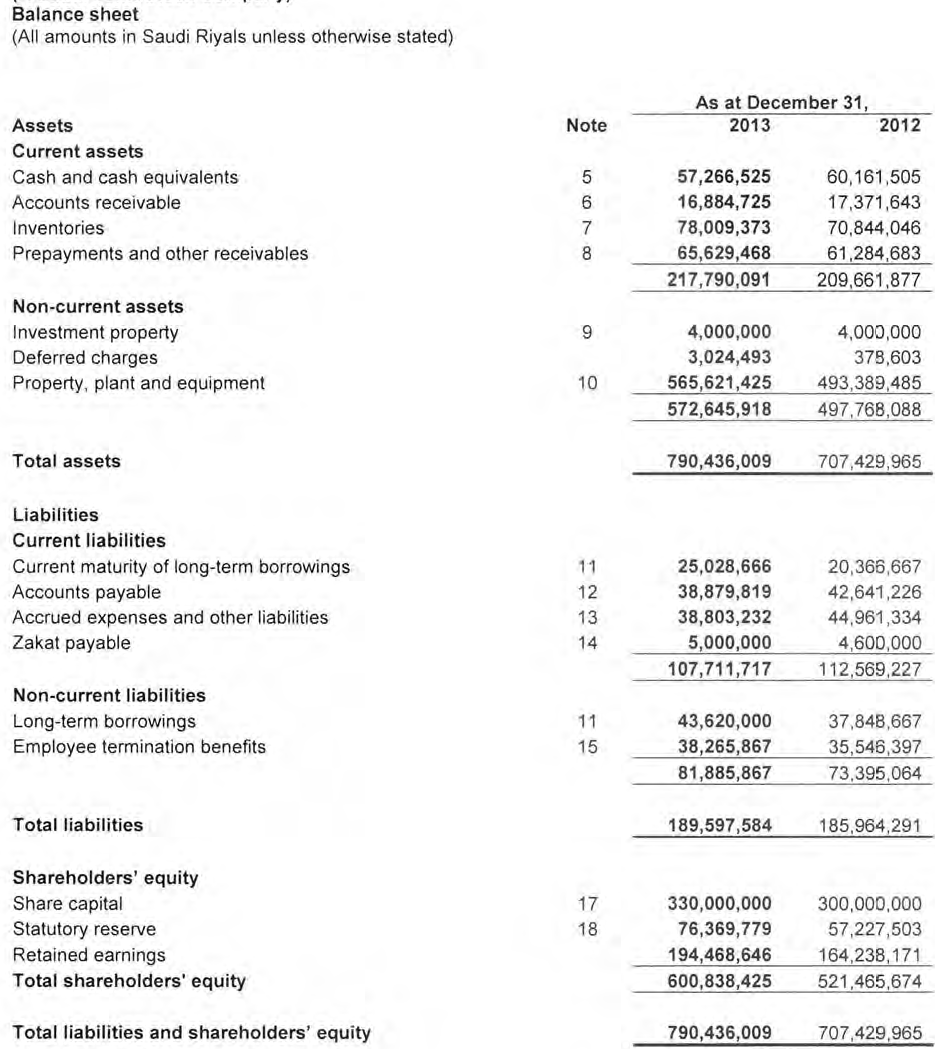
Common stock value
The company announced that it will pay SAR 1.5 dividend per share in August 2014. It also reinvested retained earnings, which boosted shares to 33 million at SAR 10 for every share.
The negative sentiments at the market have affected the company’s share trading and consequently, there is massive drop in share prices and volume traded since August 2014. The shares declined from a higher of 108 to 89. This reflect changes in the 2014 Q4 decline in share traded.
Herfy is optimistic that new the new branches will increase profitability and raise its share prices. Moreover, the regional expansion will increase the company’s outlook in the stock market.
General risk and return scenarios
The company’s growth strategies have resulted into increased balance sheet over the last few years. This trend is most likely to continue in the next few years as Herfy seeks regional growth and franchises. At the same time, the company’s revenues will also increase as these new restaurants and franchises will bring more profits.
The increasingly busy lifestyle will increase the demand for fast food. Moreover, the growing middle class is a good sentiment for the company.
Herfy operates principally in Saudi Riyal and the US dollar. Hence, changes in foreign exchange rates are most likely to affect its earnings. However, Saudi Riyal has always been pegged against the US dollar and any changes are minimal.
The Currency risks and fair value occur from borrowing activities, which could have fluctuating interest rates. The rates of interest could fluctuate but they are close to the market rates and therefore management believes that their impacts are minimal.
Credit risks could occur if Herfy is unable to service its debts. However, there are no significant credit risks for the company and its ongoing expansion is partially funded by shareholders.
On liquidity risk, Herfy ensures that it can raise adequate cash to meet its obligations in time.
Fair value risks are associated with assets that the company is most likely to dispose. The differences could result into low book value for the company.
As previously mentioned, the drop in oil prices have affected the Saudi stock markets and by extension the company. In addition, political turmoil in some Arab states will affect Herfy’s expansion strategies.
References
Brealey, R., Myers, S., & Allen, F. (2013). Principles of Corporate Finance (11th ed.). New York: McGraw-Hill/Irwin.
Herfy Food Services Company. (2014). About Herfy. Web.
Herfy Food Services Company. (2014). Financial Statements for the Year Ended December 31, 2013 and Independent Auditors’ Report. Web.
Meigs, R. F., & Meigs, W. (1991). Financial Accounting (7th ed.). New York: McGraw-Hill.
Tadawul. (2014). 6002 – Herfy Food Services Co . Web.
